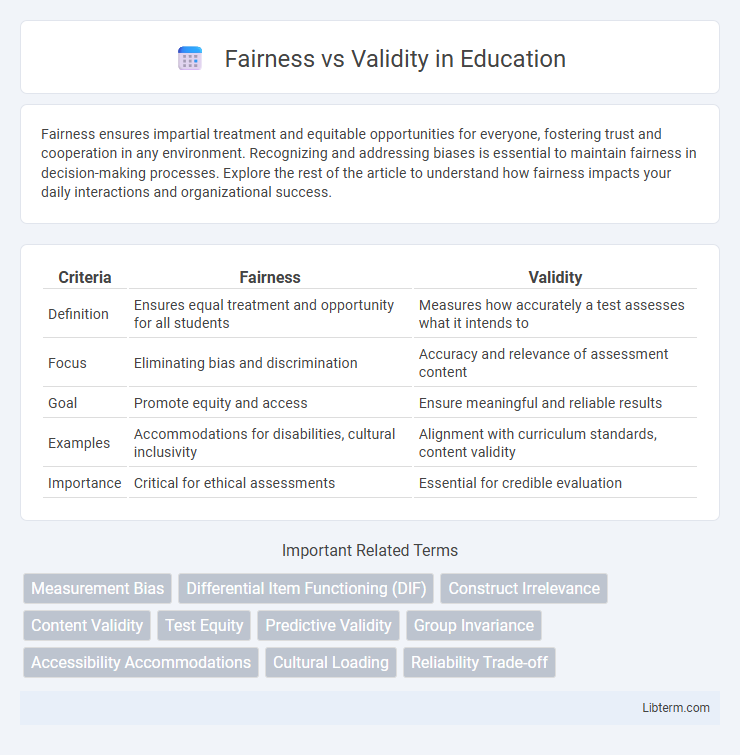Fairness ensures impartial treatment and equitable opportunities for everyone, fostering trust and cooperation in any environment. Recognizing and addressing biases is essential to maintain fairness in decision-making processes. Explore the rest of the article to understand how fairness impacts your daily interactions and organizational success.
Table of Comparison
| Criteria | Fairness | Validity |
|---|---|---|
| Definition | Ensures equal treatment and opportunity for all students | Measures how accurately a test assesses what it intends to |
| Focus | Eliminating bias and discrimination | Accuracy and relevance of assessment content |
| Goal | Promote equity and access | Ensure meaningful and reliable results |
| Examples | Accommodations for disabilities, cultural inclusivity | Alignment with curriculum standards, content validity |
| Importance | Critical for ethical assessments | Essential for credible evaluation |
Introduction to Fairness and Validity
Fairness in assessments ensures that evaluation methods are free from bias and provide equal opportunities for all test-takers, promoting equitable treatment regardless of background. Validity refers to the degree to which an assessment accurately measures what it intends to assess, reflecting the true abilities or knowledge of the individuals. Both fairness and validity are critical in creating reliable and just testing environments that yield meaningful and actionable results.
Defining Fairness in Assessment
Fairness in assessment ensures equal opportunity for all test-takers by eliminating bias related to gender, ethnicity, socioeconomic status, or disability. It emphasizes transparent criteria, culturally responsive content, and accommodations that maintain assessment validity while providing equitable measurement. Balancing fairness requires rigorous validation to confirm that assessments accurately reflect the intended skills without disadvantaging any subgroup.
Understanding Validity in Measurement
Validity in measurement assesses the degree to which a test or instrument accurately measures the intended construct, ensuring that results reflect true characteristics rather than extraneous factors. Ensuring validity involves techniques such as content validity, criterion-related validity, and construct validity to confirm that the measurement aligns with theoretical concepts and practical applications. Understanding validity is crucial for differentiating between fair assessments and those that merely produce consistent but potentially misleading outcomes.
Key Differences Between Fairness and Validity
Fairness primarily addresses the ethical dimension of a process, ensuring equitable treatment and absence of bias across diverse groups, whereas validity measures the accuracy and effectiveness of a tool or assessment in achieving its intended purpose. Fairness depends on social and moral principles, while validity relies on empirical evidence and statistical analysis to confirm reliability and relevance. Understanding these distinctions is critical for developing assessments that are both just and scientifically sound.
The Interdependence of Fairness and Validity
Fairness and validity in assessments are interdependent, as the accuracy of a test's predictions (validity) directly influences its fairness to all examinees. When a test validly measures the intended constructs without bias, it supports equitable outcomes across diverse groups. Ensuring both fairness and validity requires continuous evaluation of test content, scoring methods, and differential item functioning to maintain an unbiased and accurate assessment framework.
Challenges in Balancing Fairness and Validity
Balancing fairness and validity in assessment presents challenges such as mitigating bias without compromising the accuracy of measuring intended constructs. Ensuring fairness requires addressing demographic disparities and cultural differences, which can sometimes conflict with maintaining test validity. Developing assessment tools that provide equitable opportunities while preserving psychometric soundness remains a complex endeavor for educators and policymakers.
Fairness in Educational Testing
Fairness in educational testing ensures that assessments provide equitable opportunities for all students regardless of background, culture, or language proficiency. It addresses biases that may disadvantage specific groups, aiming for inclusive test design and administration. Valid fairness practices help produce more accurate measurements of student ability and support equitable educational outcomes.
Validity in Psychological Assessment
Validity in psychological assessment ensures that the test accurately measures the intended psychological construct, such as intelligence, personality traits, or mental health disorders. It encompasses various types, including content validity, criterion-related validity, and construct validity, each crucial for establishing the test's relevance and accuracy in representing the targeted attribute. High validity is essential for making reliable clinical diagnoses, guiding effective interventions, and supporting sound research conclusions in psychology.
Strategies to Improve Both Fairness and Validity
Implementing bias mitigation techniques such as reweighting training data or adjusting algorithmic decision thresholds can enhance fairness while maintaining validity in machine learning models. Conducting thorough validation with diverse demographic datasets ensures both equitable treatment across subgroups and accurate predictive performance. Incorporating transparency and explainability tools helps identify and address unfair biases without compromising the model's validity.
Future Directions for Fair and Valid Assessments
Emerging research in psychometrics emphasizes integrating fairness and validity through algorithmic transparency and bias mitigation in adaptive testing. Advances in machine learning enable development of assessments that dynamically adjust to diverse populations while preserving construct validity. Future directions include cross-disciplinary frameworks combining ethical AI, data governance, and continuous validity monitoring to ensure equitable measurement outcomes.
Fairness Infographic

 libterm.com
libterm.com